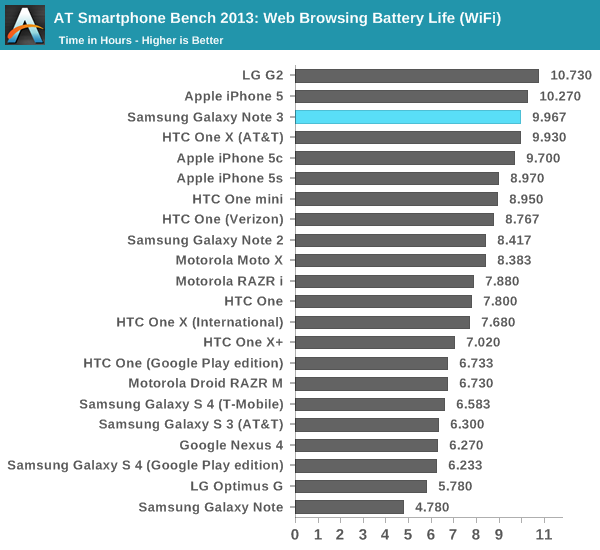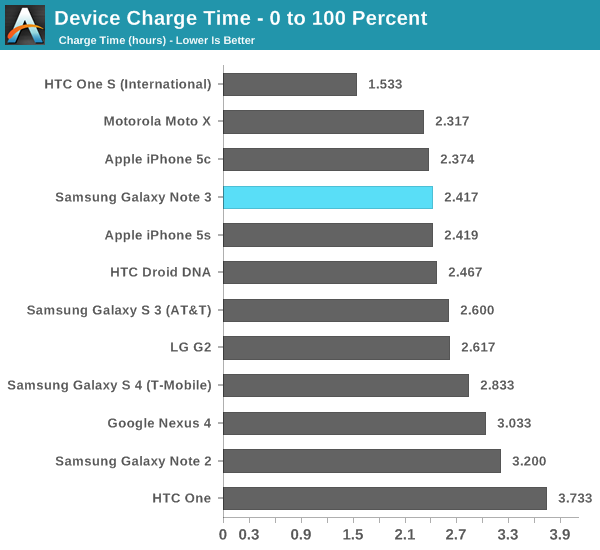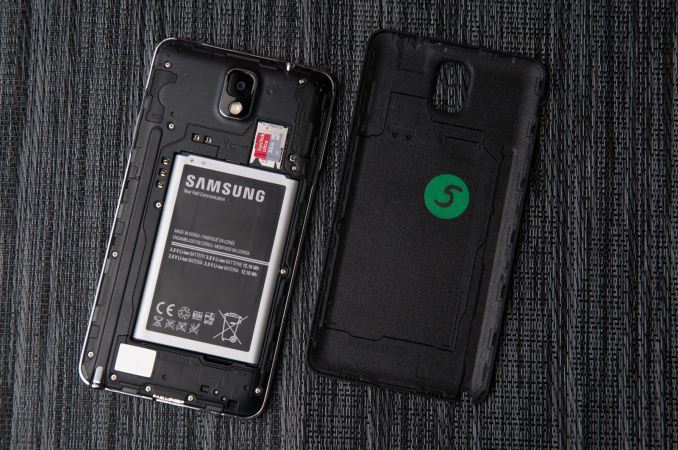Samsung Galaxy Note 3 Review
by Brian Klug on October 1, 2013 9:00 AM EST- Posted in
- Smartphones
- Samsung
- Mobile
- Android 4.3
- galaxy note 3
Battery Life
Battery life remains probably the single largest differentiator for devices lately, and of huge concern to enthusiasts and normal shoppers alike. We’ve already caught a glimpse of how well 8974 fares from a power perspective inside the LG G2, a device that posted some seriously impressive battery numbers. The Note 3 we’re looking at is also 8974 based since it’s a T-Mobile model, and thus we expect the same kind of battery life.
With this generation of Note, battery gets even larger. The Note started with a then quite large 9.25 watt hour battery, then Note 2 moved to 11.78 watt hours, and Note 3 now moves to a very large 12.16 watt hour battery with of course the newest 3.8V chemistry and all that comes along with it. Display size goes up, but those power gains are offset in other places.
After we talked about the panel self refresh features in the G2 a few people reached out and let me know that this feature has been shipping for a while in some phones, and it’s easy to check for. If we look under the display subsystem we can see that the same MIPI_CMD_PANEL type 9 is used, which refers to this type of interface.
Qualcomm HWC state: MDPVersion=500 DisplayPanel=9
define MIPI_CMD_PANEL ‘9’
Our battery life tests are unchanged and consist of a set of popular webpages that are loaded on a schedule with the display set to exactly 200 nits and repeated until the battery runs out and the device dies on both WiFi and cellular data connections. In this case that means T-Mobile LTE which is 10 MHz FDD in my market, I haven’t had a chance to run the Note 3 on HSPA+ yet, or complete the call test (which is starting to get ridiculous, and probably breaks 24 hours in the case of the Note 3).

On LTE the Note 3 does very well, coming just shy of the pack of iPhones, at just over 8 hours. Interestingly enough it’s just north of the G2s as well, which do have a smaller battery but also smaller display. The Note 3 also is the first device to ship with Qualcomm’s QFE1100 envelope tracker solution from the RF360 front end portfolio, which lowers power consumption by up to 20 percent and heat dissipation by up to 30 percent by allowing the power amplifiers to follow the desired output waveform. There’s more on that later in the cellular section.

On WiFi the Note 3 does better by 22 percent, but not the kind of huge jump I’m used to seeing between cellular and WiFi testing. This tells me the Note 3 battery life is really gated by the display, which is almost always the largest consumer of power in a device. That said the Note 3 does very well all things considered, especially in comparison to the APQ8064 (Fusion 3) phones which came before it, like SGS4. New silicon and new process inside MSM8974 definitely helps move battery life forward here with the race to sleep game.
Charging is an interesting story on the Note 3, but primarily because of what doesn’t change. The Note 3 continues to use Samsung’s tablet charging specification and charger, which has 2 amps of maximum output. The Note 3 draws 2 amps over a considerable amount of the charging curve, like other Samsung devices (in the linear part of the charge curve). USB 3.0 doesn’t change things up here quite yet with the new supported charge voltages that are coming eventually with the power delivery specification.

The Note 3 does charge faster overall compared to the SGS4 however thanks in part to the new PMIC (PM8941) which is part of the overall 8974 platform story.











302 Comments
View All Comments
ESC2000 - Monday, October 7, 2013 - link
I'm not sure how anyone could consider the body of work on this site and conclude that it is biased in favor of Samsung.Spunjji - Tuesday, October 8, 2013 - link
They couldn't. But these guys are all weighing in after one single review that they did not read correctly.repoman27 - Wednesday, October 2, 2013 - link
Anand, could you please hurry up and post your review of the new iMacs so I can read 150 comments about how this site is so Apple biased? I'm really tired of reading all these comments about how this is obviously no longer the best review site on the Internet because Ars Technica has uncovered something you've been reporting about continuously for 2 months now.Maybe all the long time readers who are so outraged by Brian's misrepresentation missed the past couple podcasts, or the article that really broke the whole story: http://www.anandtech.com/show/7187/looking-at-cpug...
1ndian - Wednesday, October 2, 2013 - link
"whose awkward double lobed shape gives it forwards compatibility with microUSB 2.0" it should be "backward compatibility"Spunjji - Tuesday, October 8, 2013 - link
I think they meant what they said. The MicroUSB 2 cable is forwards-compatible with the MicroUSB 3 socket, whereas the MicroUSB 3 cable is not backwards-compatible with MicroUSB 2. Ir's a slightly different way of saying something similar.Truth.lover - Wednesday, October 2, 2013 - link
Dear Anand. I Loved your site with their deep insightful reviews until today. You are hurting yourself so much by not explicitly stating who commits benchmark fraud and who doesn't. You should take down these benchmark numbers or replace them by accurate ones that arstechnica shows how to get. If not you shouldn't be surprised why samsung et al are not stopping the benchmark doping. You also should not be surprised why readers will leave you. We need journalism. The fourth pillar of democracy. Consider me gone.BMNify - Wednesday, October 2, 2013 - link
Disappointed by Anandtech's decision of showing cooked benchmarks in the benchmark table which will be posted everywhere on the web as reality.wrkingclass_hero - Wednesday, October 2, 2013 - link
People, quit bitching about the benchmarks and harassing Brian and Anand. Keep in mind who originally broke the story. In short order there will be an article on Anandtech discussing boosting in Android, and you will see that Samsung is not alone.I personally admire the tact that they have shown.
JMFL - Wednesday, October 2, 2013 - link
Anand and Brian,I am so disappointed that you have apparently passed given Samsung a pass on their benchmark shenanigans. Simply stating that other manufactures do the same without pointing out which manufacturers do so is trite. It also encourages future shenanigans.
Giving you the benefit of the doubt, I'm hoping that you both are simply preparing for a story that sheds light on the phone industry as a whole in terms of benchmark tweaking. If this is not the case, I think that your site has lost it's status as the premier site for technical reviews.
At the very least, on the benchmark charts, results for the Note 3 should be amended with a star noting that there is a tweak involved. Or better yet, also run the benchmarks in a manner that Arstechnica did and show both results. In fact, I can't see any credible reason why your wouldn't do this!
Squuiid - Wednesday, October 2, 2013 - link
"I'm hoping that you both are simply preparing for a story that sheds light on the phone industry as a whole in terms of benchmark tweaking. If this is not the case, I think that your site has lost it's status as the premier site for technical reviews."Exactly my thoughts. I was hoping for the same, but it's almost as if Anand has pressed a self destruct button for his site. This sham review has done irreparable damage to Anandtech's reputation, and given the many comments backing this up, I cannot understand why Anand hasn't come out and clarified the situation by doing as you suggest. In fact, his comments have only made things worse by suggesting that 'everyone is doing it' and so it is ok not to flag it. Wha?!